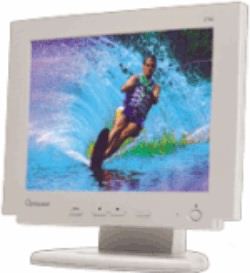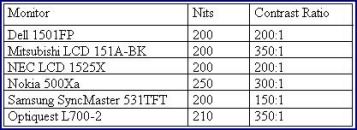|
Review: Optiquest L700-2
Ed "Brandor" Reddy
There has been a lot of discussion the past few years on the emerging technology of LCD TV's. We have all seen them in one form or another. Calculators, watches, and lately ATMs at the local bank all use different types of LCD screens. The computer industry has been using LCD monitors for a number of years in laptops. Apart from obvious information we have about LCD panel displays such as poor resolution and clarity CRT monitors, little is known about LCD panel monitors. With the increasing popularity of LCD monitors, there is a growing interest. I was curious how applicable are LCD monitors to the gaming market. Did they offer any benefits over CRT tube monitors? How about price, were they competitive? To investigate this solution and to answer our questions, we received Optiquest's L700-2 LCD 15.1" panel monitor for review. The results you may find surprising…

LCD History
LCD displays first appeared back in 1963 from a gentleman working at RCA by the name of Williams. He discovered the pros and cons of light passing through liquid crystals when it is stimulated by an electrical charge. Another RCA researcher five years later named Heilmeyer made a display sample using Williams' concept. Since then LCD's have become a common output device for a variety of machines, most popular in calculators and watches. Recent advances in LCD technology have broadened the uses of LCD displays most noticeably into the computer monitor market. Sharp, NEC and Viewsonic now manufacture and distribute LCD panel monitors as part of their product lineup. Laptop computers would probably not exist if it were not for the LCD monitor they all use. As a lightweight device with low power requirements, LCD's are the laptops saving grace.
The typical LCD monitor is flat, narrow, emits low amounts of EF, offers flicker free displays and has very low power and space requirements. CRT on the other hand is almost 100 years old, invented in 1901 by Allen B DuMont. CRT, which stands for cathode-ray tube, is a power intensive design compared to the LCD because of the high voltage requirements. The tubes may be large and bulky, but they offer extremely high resolutions and clearness most LCD's are not able to produce.
In our office we currently have an Optiquest Q95 CRT monitor. It has an 18" viewable CRT and weighs almost 50 pounds, has a dot pitch of .23, a maximum resolution of 1600x1200, consumes an average 110 watts (110 joules per second) and costs about $325. The L700-2 has a 15.1" viewable LCD and weighs 11 pounds, 210 nits of luminance and a 350:1 contrast ratio, a maximum resolution of 1024x768, consumes 38 watts (38 joules per second), and costs over $1000. By this assessment it is obvious there are some vast differences between CRT and LCD monitors. The biggest difference is the price and available resolution. The price of a LCD that supports resolutions up to 1600x1200 will cost you over $3000.

With LCD monitors, there are two very important terms to consider. The first is NIT, and the second is Contrast Resolution. A "NIT" is a unit of illuminative brightness equal to one candle per square meter, measured perpendicular to the rays of the source (source:dictionary.com). Contrast Ratio is the difference between the dark part of the picture and the light area of the picture. It is calculated by dividing the peak white level by the light level at the dark park of the picture (source videoessentials.com). The L700-2 we received has 210 nits of luminance (brightness) and a 350:1 contrast ratio (dark/light difference). Both of these numbers are good for a monitor of this size and price. Coupled with a 1024x768 native resolution, the L700-2 gives us a decent screen quality and bright clear pictures. When the L700-2's specifications are compared to other Flat Panel monitors in the same price and size class, the Optiquest pretty much leads the pack.

To Page 2 of 2
Copyright © 1997 - 2000 COMBATSIM.COM, INC. All Rights Reserved. |
